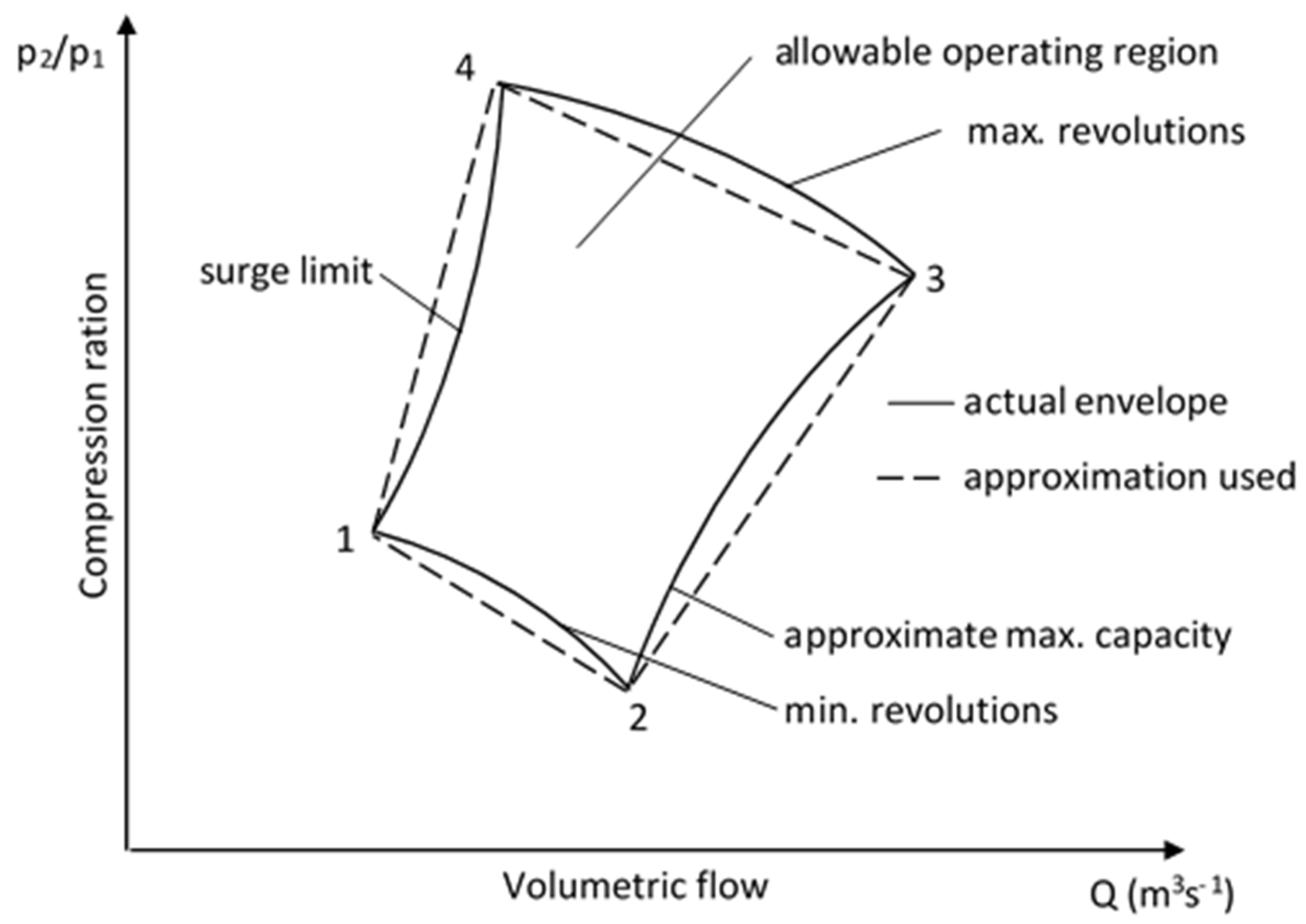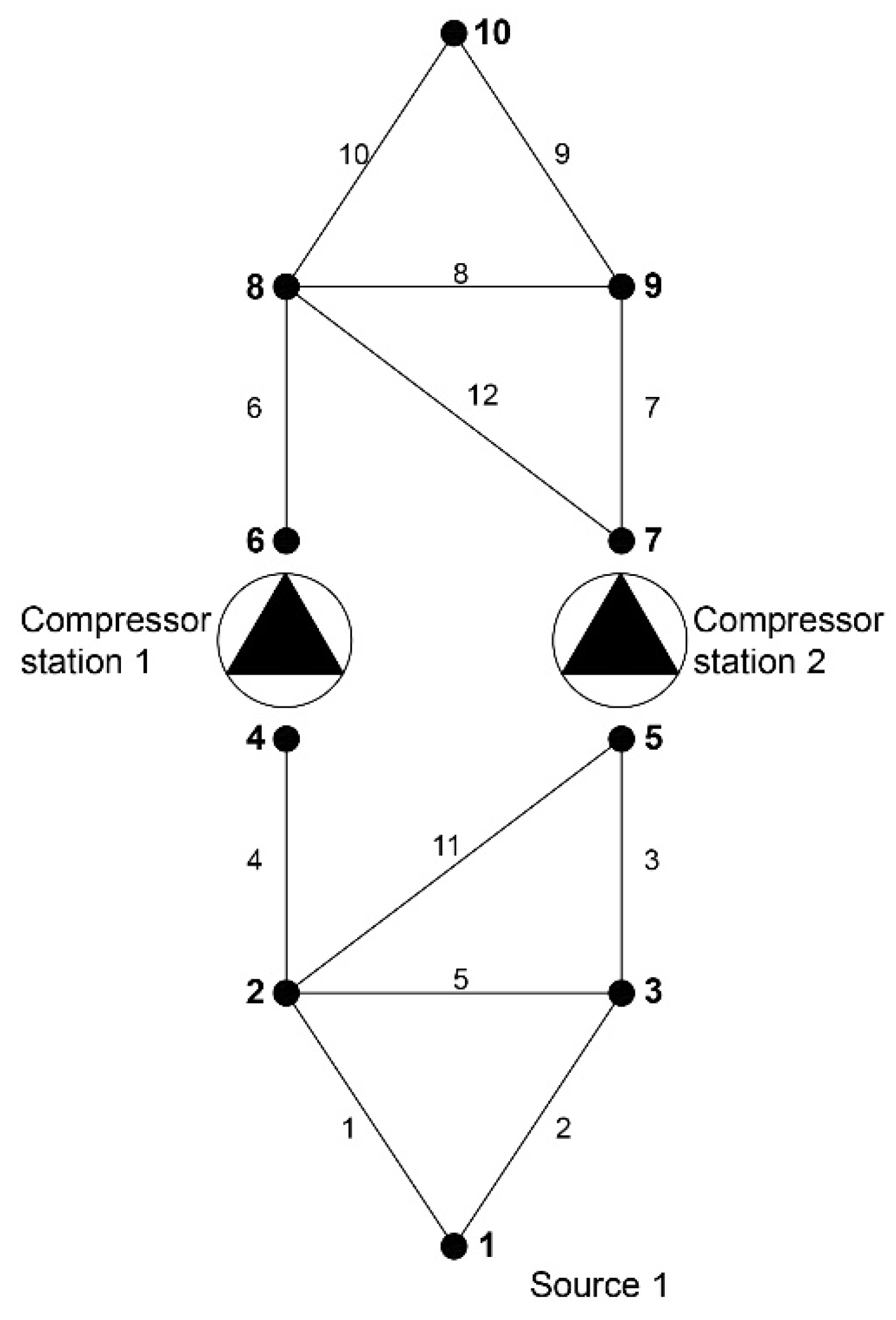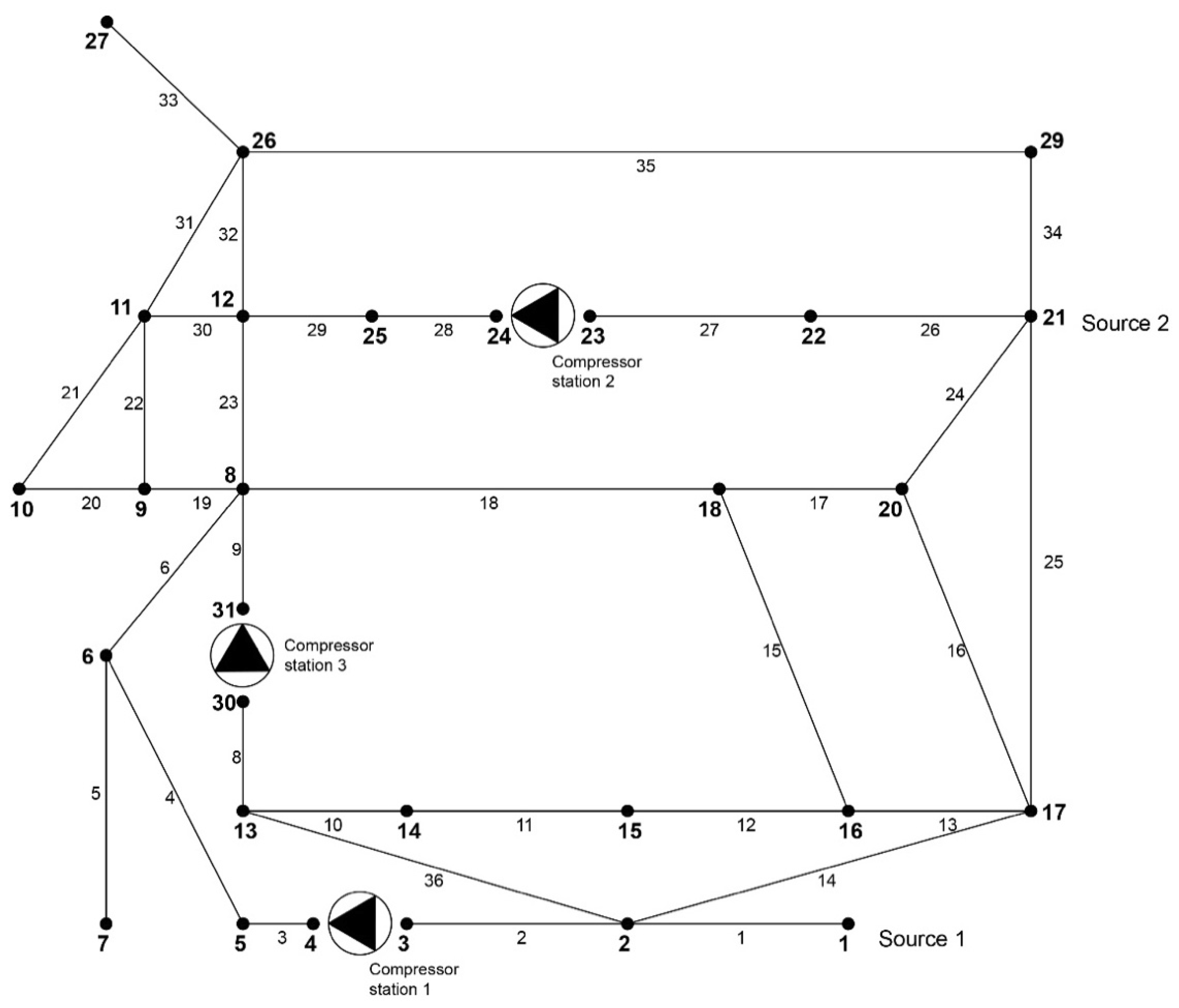1. Introduction
The introduction of a Third Party Access (TPA) regime has been a central element of liberalization of the gas industry. The objective is to foster competition in the gas market, improve supply efficiency and bolster infrastructural investments, thereby strengthening energy security. However, TPA provisions have a game-changing impact on the gas supply market by introducing competition, breaking the incumbent’s monopoly, lowering prices and adding complexities to service provision by the system operator. The main responsibility of the gas network operator is to maintain safe and efficient operation of the gas supply system in real time and to ensure security of supplies in the short, medium and long term. Operation optimization of natural gas pipelines has received increasing attentions due to such advantages as maximizing the operating economic benefit and the gas delivery amount.
This paper is concerned with the high-pressure gas networks under steady-state conditions. If we assume that the goal is to minimize the operational costs, then the steady-state optimization algorithm determines the pressure values in the network nodes, flow values in the pipes, flows in the compressor stations and the compression ratio of compressor stations, minimizing the objective function.
Different methods are proposed in the literature to solve the problem of this nature. In particular, non-linear models are applied because non-linearities can be represented in their original form. In [
1] mixed integer non-linear programming is used to tackle the steady-state case; In [
2] sequential linear programming is employed to study the behaviour of an integrated gas and power system. In [
3] mixed integer linear programming is applied for the steady-state optimization of gas flows. Nowadays, it is possible to state that mixed integer linear programming techniques are mature because they are fast, robust, and are able to solve problems with up to hundreds of thousands of variables [
4].
Several locally mixed integer linear programming formulations used to piecewise linearize a non-linear function have been proposed in the literature. A unified framework can be found in [
5].
It should be noted that the gas network control is a complex process which can be operated on the basis of various criteria. The criteria are formulated by the network operator and depend primarily on the operating conditions of the network, structure of the network, its hydraulic properties and type of consumers. Under certain conditions, scalar optimization is sufficient to satisfy the operator requirement while in other cases one should look for compromise solutions, which are optimization problems with an objective function in the form of vector.
Solving the single objective optimization problems is far more common than solving the multi-objective problems, since there appears to be no generally effective and efficient method available for solving the multi-objective problems directly as they are. Typically, a multi-objective problem is to be effectively converted to a single objective problem before applying an optimization algorithm. This conversion can be done easily by first deciding the relative importance for each objective a priori. Then, for example, the decision-maker may combine the individual objective functions into a scalar cost function (linear or non-linear combination), which effectively converts a multi-objective problem into a single objective one.
Nonetheless, there are more and more papers in which the task of gas transmission system optimization is formulated as a multi-criteria task.
In [
6] a bi-criteria optimization algorithm is formulated (running cost and maximum capacity) to solve a simple structure of the network, assuming a steady-state flow.
In [
7] an algorithm for the optimization of design and operation of a gas transmission system is employed. The objective function consists of two components: one describes the costs of construction and operation of pipelines while the other specifies the costs of construction and operation of the compressor station. The problem was solved using mixed non-linear programming
In [
8] an algorithm for investment and operational costs minimization of a high-pressure gas network is applied. The mixed integer non-linear programming was used to find optimal suction and discharge pressures of a fixed number of compressor stations, as well as the length and the diameter of the pipeline segments. The optimization goal was to minimize the annual costs, assuming 10-year investment depreciation. The main disadvantage of this algorithm is the assumption that pipeline diameters are treated as continuous variables.
In the paper by [
9], a multi-objective ant colony optimization technique for pipeline optimization has been developed to solve the multi-objective gas pipeline transportation problem. The multi-objective problem considered is about minimizing fuel consumption in the compressors and maximizing the throughput.
In [
10] a multi-objective optimization method to trade-off reliability and power demand in the decision-making process is developed. In the optimization, the steady-state behaviour of the natural gas pipeline networks is considered, but the uncertainties of the supply conditions and the customer consumptions are accounted for. The multi-objective optimization is about finding the operational strategies which minimize power demand and the risk of gas supply shortage.
In [
11] three objective functions to simultaneously optimize: minimizing the fuel consumption in the compressor stations, maximizing the network throughput and maximizing the percentage of added hydrogen at the network entrance is employed. The
NSGA-IIb genetic algorithm coupled with a Newton–Raphson procedure of the MATLAB toolbox (MathWorks, Inc., Natick, MA, USA) is implemented.
In [
12] the short- and medium-term planning problems of the regimes of multi-line technical gas pipeline corridors (MLGP) of the Russian gas supply system is considered. The fall in gas production caused by depleted gas fields leads to a decrease in the load of some operating MLGPs.
The purpose of this article is to develop and test mathematical models and a computer program in order to support the adoption of dispatch solutions for managing modes of large MLGPs under conditions of incomplete loading.
The paper by [
13] addresses the Line Pack Management of the “GZ1 Hassi R’mell-Arzew” gas pipeline. For a gas pipeline system, the decision-making on the gas line pack management scenarios usually involves a delicate balance between minimizing fuel consumption in the compression stations and maximizing the gas line pack. In order to select an acceptable Line Pack Management of Gas Pipeline scenario from these two angles for “GZ1 Hassi R’mell-Arzew” gas pipeline, the idea of multi-objective decision-making has been introduced.
Pipeline failures due to natural disasters, corrosion and manufacturing defects have generated a tremendous economic loss. To recover efficiently from the disruption with a minimum loss, [
14] propose a multi-objective optimization model that minimizes both the loss from disruption and recovery time. Recovery on disrupted pipelines may incur an additional recovery cost but, on the other hand, it can alleviate the cost of unmet demand. Considering the gas production and transmission costs, we use multi-objective optimization to study the recovery decisions in a pipeline network.
The paper by [
15] proposes the multi-objective optimization of the design of natural gas transmission networks to support the decision of regulatory authorities. Problem formulation involves two objective functions: minimization of the transportation fare and maximization of the transported gas volume. These design parameters of the pipeline project must be previously established by the regulatory agency, considering an attractive return on investment for the entrepreneurs and the demands of current and future consumers.
2. Bi-Criteria-Objective Function
In our case, the objective function is formulated in the following form:
where:
f1(x)—objective function for running cost;
f2(x)—objective function for gas line pack;
xT = [pt1, pt1,…, ptk]—vector of discharge pressure;
α1, α2—weighting factors (α1 + α2 = 1) indicating relative significance of the objective functions.
The first part of this function, which expresses the running cost of the compressors, should be minimized (minimization of the operating costs), and the second part, which expresses the line pack, should be maximized (ensuring delivery security). In order to establish a relationship between the two functions, weighting factors were used. In this case study, it was assumed that both functions are equally important for the user, therefore the weighting coefficients are equal to 0.5. Weights must be constant and must be functions of the original objectives. The values of the weighting factors are arbitrarily chosen by the user (transmission system operator). Depending on the hydraulic properties of the system, the capacity, the structure, the number of compressor stations and on the amount of the transported gas, the operator decides what is more important: the running cost of the compressor stations or security of gas supply.
The elements of vector x are discharge pressure values of the working compressor stations. Determining components of the x vector, which will minimize the formulated objective function is the solution to the bi-criteria optimization problem. This involves finding such discharge pressure values for each compressor station which will ensure that the operational costs of the transmission system will be a compromise between maximizing line pack costs and minimizing running costs.
Minimizing the running costs of the transmission system is equivalent to minimizing power consumption in the compressor stations. The total power consumption in the system is expressed by Equation (2):
where:
Ni—power consumption for the i-th compressor station [W];
n—isentropa exponent;
pa—absolute pressure [Pa];
Qs—volumetric gas flow through the i-th compressor station at standard conditions [m3/h];
Zs—gas compressibility factor for the suction [-];
Ts—temperature for the suction [K];
Ta—absolute temperature [K];
η—adiabatic efficiency;
pd,i—discharge pressure for the i-th compressor station [Pa];
ps,i—suction pressure in for the i-th compressor station [Pa];
k—number of switch-on compressor stations in the system [-].
The second part of the objective function relates to gas line pack in the network. Total gas volume in the network as a function of geometrical dimensions of the pipelines, and gas parameters can be expressed by the following Equation (3):
where:
V—volume of gas in the network [m3];
pav,i—average pressure in the i-th pipeline [Pa];
px—pressure at the sending node of the pipeline [Pa];
py—pressure at the receiving node of the pipeline [Pa];
Zi—gas compressibility factor for the i-th pipeline [-];
T—gas temperature in the pipeline [K];
Di—internal diameter of the i-th pipeline [m];
Li—length of the i-th pipeline [m];
m—number of pipelines in the system [-].
In order to compare the power consumption as a result of running cost minimization with power consumption as a result of line pack maximization, the second term of objective function was expressed by Equation (5):
where:
Ns—power loss corresponding to given flow parameters [W],
Qv,i—volumetric gas flow through the i-th pipeline at real conditions [m3/s],
—pressure drop for the i-th pipeline [Pa].
The results of calculations (see
Table 1) have shown that the greater line pack in the network, the higher operational costs of the compressor station. Calculations were made on the pipeline with an internal diameter of 0.7 m and a length of 50 km.
This means that the first part of the objective function is to be minimized and the second part is to be maximized. We are searching for an appropriate discharge pressure values for working compressor stations which will ensure a compromise between these two components.
6. Results Analysis
Table 11 presents the results of the tested networks. In each scenario, the bi-criteria optimization objective function value was lower than the value of arithmetic average of the objective function of minimizing power and maximizing gas capacity.
The difference increases as the dimension of the network increases. For networks 1, 2 and 3, the differences are 10%, 17% and 28%, respectively. Comparison of optimization results is presented in
Figure 5.
The costs of compressor stations electric energy consumption were calculated for each scenario assuming that 1 kWh of electricity costs 0.55 Polish zloty (PLN). They are shown in
Table 12 and
Table 13.
Cost minimization should not be the only criterion to manage the transmission system. It should be noted that the operator is responsible for gas delivery to the customer under specific terms. It may occur that in certain situations (forecast error, sudden change in ambient temperature, inconsistent gas consumption with the contract by one of the recipients), the operator will not be able to ensure the gas supply under specific parameters resulting from the concluded contracts. Security of supply in all conditions can be achieved by increasing the gas line pack in the network, which in turn results in increased system operational costs. This means that gas transmission system optimization should take into account two factors: minimization of fuel consumption in terms of operating costs and maximization of gas line pack in the system in terms of ensuring delivery security. Therefore, the algorithm should find a compromise solution between these two factors.
The presented tables clearly show that using bi-criteria optimization to manage the gas transmission network is cheaper than in the case of scalar optimization treated as an arithmetic average of the objective function of power minimization and line pack maximization.










